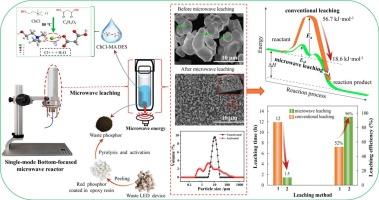基于新型单模底聚焦微波反应体系的废荧光粉深共晶溶剂中稀土金属钇的高效浸出
IF 7.1
2区 环境科学与生态学
Q1 ENGINEERING, ENVIRONMENTAL
引用次数: 0
摘要
微波辅助浸出技术是一种从二次资源中回收有价金属的高效绿色技术。然而,传统的多模反应器存在能量密度低、稳定性差等局限性,制约了其在深共晶溶剂(DES)等新兴绿色体系中的应用。在本研究中,开发了一种新型的单模底部聚焦微波反应系统,该系统具有特殊设计的反应器和原位温度传感器系统,以提高钇(Y)的回收率。所开发的微波反应使微波能量能够直接准确地作用于浸出系统底部的固液界面,与传统的多模谐振器系统相比,具有更高的功率密度、更高的可靠性和可重复性。在优化条件下,微波辅助DES浸出废荧光粉中的Y,浸出率达到95.7%。微波功率(20 W)、微波辐射时间(1.5 h)、液固比(8:1)和含水量(7.5%)较常规浸出(52.0%)显著降低,浸出时间从12 h显著缩短至1.5 h。此外,通过现场温度监测(70 ~ 140℃)进行的非等温动力学分析表明,微波浸出的活化能(Ea)为18.6 kJ/mol,显著低于常规浸出(56.7 kJ/mol)。这一发现表明从化学反应控制步骤向扩散控制步骤的转变。总体而言,单模底部聚焦微波辅助DES浸出已被证明是传统多模微波浸出系统的有效替代方案,为从含rem废物中可持续回收rem提供了一种绿色、高效和节能的方法。本文章由计算机程序翻译,如有差异,请以英文原文为准。

Efficiently leaching rare earth metal yttrium in deep eutectic solvents from waste phosphors based on a novel single-mode bottom-focused microwave reaction system
The microwave-assisted leaching technique has emerged as an efficient green technology for recovering valuable metals from secondary resources. However, conventional multi-mode reactors face limitations, including low energy density and poor stability, which restrict their application in emerging green systems such as deep eutectic solvents (DES). In this study, a novel single-mode bottom-focused microwave reaction system featuring a specially designed reactor and an in-situ temperature sensor system was developed to enhance yttrium (Y) recovery. The developed microwave reaction enables microwave energy to directly and accurately act on the solid–liquid interface at the bottom of the leaching system, offering higher power density, improved reliability, and reproducibility compared to traditional multi-mode resonator system. When applied to microwave-assisted DES for leaching Y from waste phosphors, an excellent leaching efficiency of 95.7 % was achieved under optimized conditions: microwave power (20 W), microwave radiation time (1.5 h), liquid–solid ratio (8:1) and water content (7.5 %) compared with conventional leaching (52.0 %), while leaching time significantly reduced from 12 h to 1.5 h. Furthermore, non-isothermal kinetic analysis via in-situ temperature monitoring (70–140 °C) revealed an activation energy (Ea) of 18.6 kJ/mol for microwave leaching, which is remarkably lower than that of conventional leaching (56.7 kJ/mol). This finding suggests a shift from a chemical reaction control step to a diffusion control step. Overall, the single-mode bottom-focused microwave-assisted DES leaching has proven to be an effective alternative to conventional multi-mode microwave leaching system, providing a green, efficient and energy-saving approach for the sustainable recovery of REMs from REM-containing waste.
求助全文
通过发布文献求助,成功后即可免费获取论文全文。
去求助
来源期刊

Waste management
环境科学-工程:环境
CiteScore
15.60
自引率
6.20%
发文量
492
审稿时长
39 days
期刊介绍:
Waste Management is devoted to the presentation and discussion of information on solid wastes,it covers the entire lifecycle of solid. wastes.
Scope:
Addresses solid wastes in both industrialized and economically developing countries
Covers various types of solid wastes, including:
Municipal (e.g., residential, institutional, commercial, light industrial)
Agricultural
Special (e.g., C and D, healthcare, household hazardous wastes, sewage sludge)
 求助内容:
求助内容: 应助结果提醒方式:
应助结果提醒方式:


